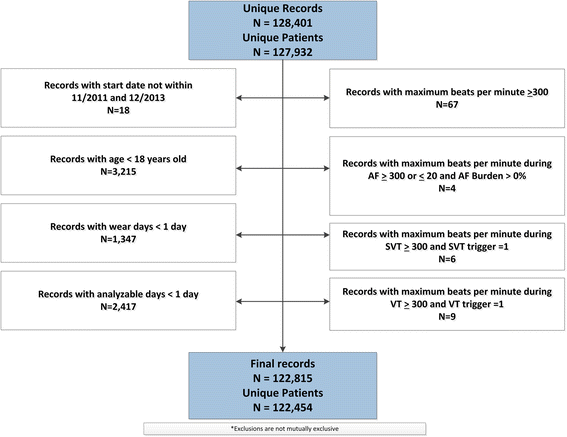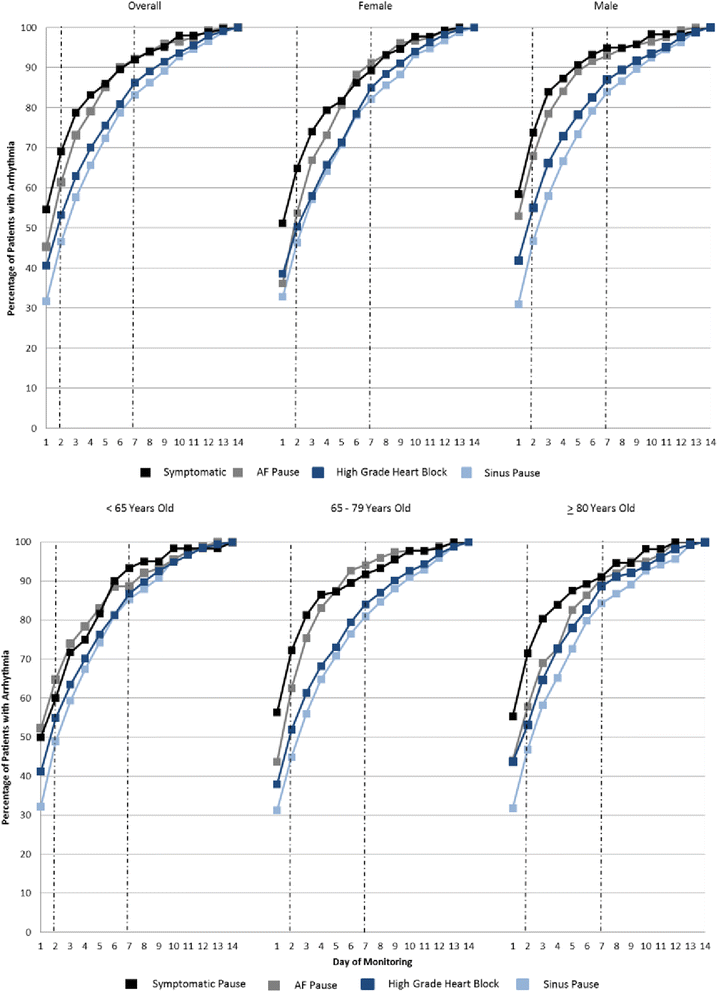Incidence and timing of potentially high-risk arrhythmias detected through long term continuous ambulatory electrocardiographic monitoring
- PMID: 26883019
- PMCID: PMC4756401
- DOI: 10.1186/s12872-016-0210-x
Incidence and timing of potentially high-risk arrhythmias detected through long term continuous ambulatory electrocardiographic monitoring
Abstract
Background: Ambulatory electrocardiographic (ECG) monitoring is the standard to screen for high-risk arrhythmias. We evaluated the clinical utility of a novel, leadless electrode, single-patient-use ECG monitor that stores up to 14 days of a continuous recording to measure the burden and timing of potentially high-risk arrhythmias.
Methods: We examined data from 122,815 long term continuous ambulatory monitors (iRhythm ZIO® Service, San Francisco) prescribed from 2011 to 2013 and categorized potentially high-risk arrhythmias into two types: (1) ventricular arrhythmias including non-sustained and sustained ventricular tachycardia and (2) bradyarrhythmias including sinus pauses >3 s, atrial fibrillation pauses >5 s, and high-grade heart block (Mobitz Type II or third-degree heart block).
Results: Of 122,815 ZIO® recordings, median wear time was 9.9 (IQR 6.8-13.8) days and median analyzable time was 9.1 (IQR 6.4-13.1) days. There were 22,443 (18.3%) with at least one episode of non-sustained ventricular tachycardia (NSVT), 238 (0.2%) with sustained VT, 1766 (1.4%) with a sinus pause >3 s (SP), 520 (0.4%) with a pause during atrial fibrillation >5 s (AFP), and 1486 (1.2%) with high-grade heart block (HGHB). Median time to first arrhythmia was 74 h (IQR 26-149 h) for NSVT, 22 h (IQR 5-73 h) for sustained VT, 22 h (IQR 7-64 h) for SP, 31 h (IQR 11-82 h) for AFP, and 40 h (SD 10-118 h) for HGHB.
Conclusions: A significant percentage of potentially high-risk arrhythmias are not identified within 48-h of ambulatory ECG monitoring. Longer-term continuous ambulatory ECG monitoring provides incremental detection of these potentially clinically relevant arrhythmic events.
Figures



Similar articles
-
Comparison of 24-hour Holter monitoring with 14-day novel adhesive patch electrocardiographic monitoring.Am J Med. 2014 Jan;127(1):95.e11-7. doi: 10.1016/j.amjmed.2013.10.003. Epub 2013 Oct 15. Am J Med. 2014. PMID: 24384108 Free PMC article.
-
Long-term recording of cardiac arrhythmias with an implantable cardiac monitor in patients with reduced ejection fraction after acute myocardial infarction: the Cardiac Arrhythmias and Risk Stratification After Acute Myocardial Infarction (CARISMA) study.Circulation. 2010 Sep 28;122(13):1258-64. doi: 10.1161/CIRCULATIONAHA.109.902148. Epub 2010 Sep 13. Circulation. 2010. PMID: 20837897 Clinical Trial.
-
Ambulatory cardiac monitoring for discharged emergency department patients with possible cardiac arrhythmias.West J Emerg Med. 2014 Mar;15(2):194-8. doi: 10.5811/westjem.2013.11.18973. West J Emerg Med. 2014. PMID: 24672611 Free PMC article.
-
Cardiac arrhythmias--update 1987.Dis Mon. 1987 Jul;33(7):365-432. Dis Mon. 1987. PMID: 3301241 Review.
-
[Syncope in bradycardic cardiac arrhythmias].Herz. 1993 Jun;18(3):182-6. Herz. 1993. PMID: 8330853 Review. German.
Cited by
-
Evaluating the benefits of home-based management of atrial fibrillation: current perspectives.Pragmat Obs Res. 2016 Oct 13;7:41-53. doi: 10.2147/POR.S96670. eCollection 2016. Pragmat Obs Res. 2016. PMID: 27799843 Free PMC article. Review.
-
Self-powered cardiovascular electronic devices and systems.Nat Rev Cardiol. 2021 Jan;18(1):7-21. doi: 10.1038/s41569-020-0426-4. Epub 2020 Sep 7. Nat Rev Cardiol. 2021. PMID: 32895536 Review.
-
Kardia Mobile applicability in clinical practice: A comparison of Kardia Mobile and standard 12-lead electrocardiogram records in 100 consecutive patients of a tertiary cardiovascular care center.Cardiol J. 2021;28(4):543-548. doi: 10.5603/CJ.a2019.0001. Epub 2019 Jan 15. Cardiol J. 2021. PMID: 30644079 Free PMC article.
-
A Clinically Evaluated Interferometric Continuous-Wave Radar System for the Contactless Measurement of Human Vital Parameters.Sensors (Basel). 2019 May 31;19(11):2492. doi: 10.3390/s19112492. Sensors (Basel). 2019. PMID: 31159218 Free PMC article.
-
Heart Disease and Stroke Statistics-2023 Update: A Report From the American Heart Association.Circulation. 2023 Feb 21;147(8):e93-e621. doi: 10.1161/CIR.0000000000001123. Epub 2023 Jan 25. Circulation. 2023. PMID: 36695182 Free PMC article. Review.
References
-
- Crawford MH, Bernstein SJ, Deedwania PC, DiMarco JP, Ferrick KJ, Garson A, Jr, et al. ACC/AHA guidelines for ambulatory electrocardiography: executive summary and recommendations. A report of the American College of Cardiology/American Heart Association task force on practice guidelines (committee to revise the guidelines for ambulatory electrocardiography) Circulation. 1999;100(8):886–93. doi: 10.1161/01.CIR.100.8.886. - DOI - PubMed
Publication types
MeSH terms
LinkOut - more resources
Full Text Sources
Other Literature Sources
Medical

